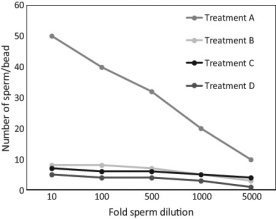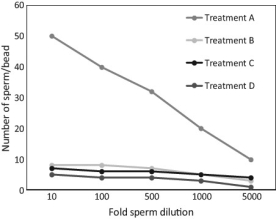A) the daughter cell with the entire gray crescent will die
B) both daughter cells will develop normally, because amphibians are totipotent at this stage
C) only the daughter cell with the gray crescent will develop normally
D) both daughter cells will develop abnormally
F) A) and D)
Correct Answer

verified
Correct Answer
verified
Multiple Choice
Use the following information to answer the question.
In order to test how sea urchin sperm bind to eggs, scientists isolated the egg receptor protein that binds to the sperm acrosomal protein called bindin. Plastic beads were coated with egg receptor for bindin (ERB1) from eggs of the sea urchin Strongylocentrotus purpuratus, and then the beads mixed with sperm from S. purpuratus or from the related species, S. franciscanus. The researchers counted how many sperm were bound to each bead. The results are shown in the graph below. (Adapted from Kamei and Glabe 2003)
Treatments:
A: S. purpuratus sperm mixed with S. purpuratus ERB1 beads
B: S. purpuratus sperm mixed with beads containing no ERB1 protein
C: S. franciscanus sperm mixed with S. purpuratus ERB1 beads
D: S. franciscanus sperm mixed with beads containing no ERB1 protein
 Based on the description of the experiment, which of the treatments would be considered a "control" treatment for S. purpuratus sperm binding?
Based on the description of the experiment, which of the treatments would be considered a "control" treatment for S. purpuratus sperm binding?
A) Treatment A
B) Treatment B
C) Treatment C
D) Treatment D
F) C) and D)
Correct Answer

verified
Correct Answer
verified
Multiple Choice
Use the following information to answer the question.
In order to test how sea urchin sperm bind to eggs, scientists isolated the egg receptor protein that binds to the sperm acrosomal protein called bindin. Plastic beads were coated with egg receptor for bindin (ERB1) from eggs of the sea urchin Strongylocentrotus purpuratus, and then the beads mixed with sperm from S. purpuratus or from the related species, S. franciscanus. The researchers counted how many sperm were bound to each bead. The results are shown in the graph below. (Adapted from Kamei and Glabe 2003)
Treatments:
A: S. purpuratus sperm mixed with S. purpuratus ERB1 beads
B: S. purpuratus sperm mixed with beads containing no ERB1 protein
C: S. franciscanus sperm mixed with S. purpuratus ERB1 beads
D: S. franciscanus sperm mixed with beads containing no ERB1 protein
 Based on the data in the graph, which of the following conclusions is supported?
Based on the data in the graph, which of the following conclusions is supported?
A) Plastic beads will bind to sperm from both species of sea urchin.
B) ERB1 prevents S. franciscanus sperm from binding the beads.
C) Sperm from S. purpuratus bind to beads only if ERB1 is present.
D) S. franciscanus and S. purpuratus are actually the same species.
F) A) and B)
Correct Answer

verified
Correct Answer
verified
Multiple Choice
One primary factor in shaping the polarity of the body axes in chick embryos is ________.
A) light
B) membrane potential
C) gravity
D) moisture
F) None of the above
Correct Answer

verified
Correct Answer
verified
Multiple Choice
The migratory neural crest cells ________.
A) form most of the central nervous system
B) form the spinal cord in the frog
C) form a variety of neural and non-neural structures
D) form the lining of the lungs and of the digestive tract
F) A) and D)
Correct Answer

verified
Correct Answer
verified
Multiple Choice
In a newly fertilized egg, the vitelline layer ________.
A) lifts away from the egg and hardens to form a fertilization envelope
B) secretes hormones that enhance steroidogenesis by the ovary
C) reduces the loss of water from the egg and prevents desiccation
D) provides most of the nutrients used by the zygote
F) B) and D)
Correct Answer

verified
Correct Answer
verified
Multiple Choice
From earliest to latest, the overall sequence of early development proceeds in which of the following sequences?
A) first cell division → synthesis of embryo's DNA begins → acrosomal reaction → cortical reaction
B) cortical reaction → synthesis of embryo's DNA begins → acrosomal reaction → first cell division
C) cortical reaction → acrosomal reaction → first cell division → synthesis of embryo's DNA begins
D) acrosomal reaction → cortical reaction → synthesis of embryo's DNA begins → first cell division
F) A) and D)
Correct Answer

verified
Correct Answer
verified
Multiple Choice
The cortical reaction of sea urchin eggs functions directly in ________.
A) the formation of a fertilization envelope
B) the production of a fast block to polyspermy
C) the release of hydrolytic enzymes from the sperm
D) the generation of an electrical impulse by the egg
F) A) and D)
Correct Answer

verified
Correct Answer
verified
Multiple Choice
Which of the following is common to the development of both birds and mammals?
A) holoblastic cleavage
B) epiblast and hypoblast
C) trophoblast
D) gray crescent
F) C) and D)
Correct Answer

verified
Correct Answer
verified
Multiple Choice
The nematode Caenorhabditis elegans ________.
A) is composed of about 1,000 cells, in which the developmental origin of each cell has been mapped
B) has only a single chromosome, which has been fully sequenced
C) has about 1,000 genes, each of which has been fully sequenced
D) uniquely, among animals, utilizes programmed cell death during normal development
F) A) and C)
Correct Answer

verified
Correct Answer
verified
Multiple Choice
The cortical reaction of sea urchin eggs functions directly in
A) the formation of a fertilization envelope.
B) the production of a fast block to polyspermy.
C) the generation of an electrical impulse by the egg.
D) the fusion of egg and sperm nuclei.
F) All of the above
Correct Answer

verified
Correct Answer
verified
Multiple Choice
The archenteron of the developing sea urchin eventually develops into the ________.
A) blastocoel
B) heart and lungs
C) digestive tract
D) brain and spinal cord
F) All of the above
Correct Answer

verified
Correct Answer
verified
Multiple Choice
In sea urchins, the "fast block" and the longer lasting "slow block" to polyspermy, respectively, are ________.
A) the acrosomal reaction and the formation of egg white
B) the cortical reaction and the formation of yolk protein
C) the jelly coat of the egg and the vitelline membrane
D) membrane depolarization and the cortical reaction
F) None of the above
Correct Answer

verified
Correct Answer
verified
Multiple Choice
Which of the following correctly displays the sequence of developmental milestones?
A) blastula → gastrula → cleavage
B) cleavage → gastrula → blastula
C) cleavage → blastula → gastrula
D) gastrula → blastula → cleavage
F) A) and C)
Correct Answer

verified
Correct Answer
verified
Multiple Choice
In mammalian eggs, the receptors for sperm are found in the ________.
A) fertilization membrane
B) egg plasma membrane
C) cytosol of the egg
D) mitochondria of the egg
F) A) and B)
Correct Answer

verified
Correct Answer
verified
Multiple Choice
Cells move to new positions as an embryo establishes its three germ tissue layers during ________.
A) determination
B) cleavage
C) induction
D) gastrulation
F) All of the above
Correct Answer

verified
Correct Answer
verified
Multiple Choice
In humans, identical twins are possible because ________.
A) cytoplasmic determinants are distributed unevenly in unfertilized eggs
B) extraembryonic cells interact with the zygote nucleus
C) early blastomeres can form a complete embryo if isolated
D) the gray crescent divides the dorsal-ventral axis into new cells
F) A) and B)
Correct Answer

verified
Correct Answer
verified
Multiple Choice
Cells transplanted from the neural tube of a frog embryo to the ventral part of another embryo develop into nervous system tissues. This result indicates that the transplanted cells were
A) totipotent.
B) determined.
C) differentiated.
D) mesenchymal.
F) C) and D)
Correct Answer

verified
Correct Answer
verified
Multiple Choice
Cell migration occurs extensively during ________.
A) organogenesis, but not during gastrulation or cleavage
B) cleavage, but not during gastrulation or organogenesis
C) gastrulation and cleavage
D) both gastrulation and organogenesis
F) A) and C)
Correct Answer

verified
Correct Answer
verified
Multiple Choice
In a frog embryo, gastrulation ________.
A) produces a blastocoel displaced into the animal hemisphere
B) occurs along the primitive streak in the animal hemisphere
C) proceeds by involution as cells roll over the lip of the blastopore
D) occurs within the inner cell mass that is embedded in the large amount of yolk
F) B) and C)
Correct Answer

verified
Correct Answer
verified
Showing 41 - 60 of 70
Related Exams